Figure 2.
Mus81-Mms4 is required for successful chromosome replication in the presence of DNA damage. (A–C) PFGE analysis. MUS81+ (W303-1a strain) and mus81Δ (YMV39 strain) cells were treated in S-phase with MMS (0.033%) for 60 min. The MMS was then removed and the cells progressed through S-phase in medium with nocodozale. (A) Cell cycle progression was monitored by flow cytometry. (B) Cell viability throughout the experiment. (C) Ethidium-bromide–stained pulse-field gel. Chromosomes are labelled with Roman numerals. (D–E) Density transfer analysis. MUS81+ (YJT110 strain) and mus81Δ (YMV17 strain) cells were blocked in G1 in medium with heavy isotopes and released then in medium with light isotopes, ±MMS (0.033%). RF progression in MUS81+ (D) and mus81Δ (E) cells was followed in a replicon of chromosome VI, using DNA probes recognizing the ClaI/SalI fragments 1–6. Probe numbers correspond to fragment numbers. The relative amounts of radioactivity in the hybridized DNA are plotted against the gradient fraction number. The positions of unreplicated (HH) and fully replicated (HL) peaks are indicated. The position of the initial HH peak is shown for comparison (grey area). Quantification of replication in the presence of MMS for every fragment and time point is shown at the bottom.

